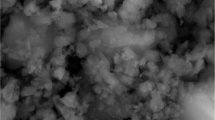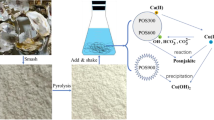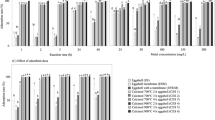Abstract
Low-cost bioadsorbent such as shrimp shell chitin was used for the removal of polyphenols and COD from olive mill wastewater (OMW). In order to achieve a high polyphenols and chemical oxygen demand (COD) removal efficiency and to reduce the number of experiments, two levels of fractional 24 factorial design experiments were carried out. The influence of different experimental parameters such as solution pH, adsorbent concentration, contact time, stirring speed, and their interactions during polyphenols and COD removal were investigated. Optimized values of pH, adsorbent concentration, contact time, and stirring speed were found equal to 12, 10 g/L, 24 h, and 420 rpm/min, respectively. The maximum polyphenol uptake under these experimental conditions reached 69.47%. Whereas the maximum removal of COD achieve 43% in 10 g/L, 12, 24 h, and 80 rpm/min for adsorbent concentration, pH, contact time, and stirring speed as optimal conditions, respectively. The experimental equilibrium data were tested using the Freundlich and Langmuir isotherm models. It was found that adsorption of polyphenols on shrimp shell chitin is well fitted both models. Kinetics of the adsorption process was studied by investigating the pseudo-first-order, pseudo-second-order kinetics, and intraparticle diffusion mechanism and showed that the pseudo-second-order kinetic model provided a better correlation for the experimental data studied in comparison to the pseudo-first-order model and intraparticle diffusion. These results revealed that shrimp shell chitin can be used as an effective and low-cost adsorbent to remove polyphenols and COD from OMW.












Similar content being viewed by others
References
Abdel-Ghani, N., Hegazy, A. K., El-Chaghaby, G., & Lima, E. (2009). Factorial experimental design For biosorption of Iron and zinc using Typha domingensis phytomass. J Desalination, 249, 343–347.
Abdelhafez, A., & Jianhua, L. (2016). Removal of Pb (II) from aqueous solution by using biochars derived from sugar cane bagasse and orange peel. J Taiwan Institute of Chemical Engineers, 000, 1–9.
Abidar, F., Morghi, M., Abali, M., Sinan, F., Chiban, M., Eddaoudi, H., & EtZebret, M. (2016). Orthophosphate ion adsorption onto raw shrimp shells. Revue des Sciences de l’Eau, 29, 197–211.
Achak, M., Hafidi, A., Mandi, L., & Ouazzani, N. (2014). Removal of phenolic compounds from olive mill wastewater by adsorption onto wheat bran. J Desalination and Water Treatment, 52, 2875–2885.
Achak, M., Hafidi, A., Ouazzani, N., Sayadi, S., & Mandi, L. (2009). Low cost biosorbent “banana peel” for the removal of phenolic compounds from olive mill wastewater: Kinetic and equilibrium studies. J HazardousMaterials, 166, 117–125.
Achak, M., Ouazzani, N., Yaacoubi, A., & Mandi, L. (2008). Caractérisation des margines issues d’une huilerie moderne et essais de leur traitement par coagulation-floculation par la chaux et le sulfate d’aluminium. J Revue des sciences de l'eau, 21, 53–67.
AFNOR (1983). Recueil de norme française: eau, méthodes d’essai, 2éme édition, Paris, pp. 621.
Aggoun-Arhab, M. (2016) Caractérisation de la composition en microconstituants des margines issues de la production oléicole et utilisabilité comme complément dans la ration chez la vache laitière. Memoire doctorat. Option: Biotechnologies Alimentaires. République Algérienne.
Akal, F. (2005). Sorption of phenol and 4-chlorophenol onto pumice treated with cationic surfactant. J Environmental management, 74, 239–244.
American Public Health Association APHA 1992. Standard methods for analysis of waste and waste water, 18th ed., APHA,Washington, DC, 1992.
Azbar, N., Keskinet, T., & Catalkaya, E. C. (2008). Improvement in anaerobic degradation of olive mill effluent (OME) by chemical pretreatment using batch systems. J Biochem. Eng., 38-379.
Azzam, M.O. (2018). Olive mills wastewater treatment using mixed adsorbents of volcanic tuff,natural clay and charcoal. J Environmental Chemical Engineering, 6, 2126–2136.
Azzam, M. O., Al-Malah, K., Al-Gazzawi, Z., & Al-Omari, S. (2010). Dynamic treatment response of olive mills wastewater using series of adsorption steps. J Clean – Soil, Air, Water, 38, 822–830.
Bailey, G.E., Ollis, D.F. (1986). Biochemical engineering fundamentals, 2nd ed., McGraw Hill, New York 393–394.
Barbera, C., Maucieri, C., Cavallaro, V., Ioppolo, A., & Spagna, V. (2013). Effects of spreading olive mill wastewater on soil properties and crops, a review. J Agric. Water Manag., 119, 43–53.
Belaid, C., Kallel, M., Elleuch, B. (2002). Identification de nouveaux composés phénoliques présents dans les rejets liquides d’huileries d’olive (margines). Déchets - revue francophone d’écologie industrielle - n° 27 - 3ème trimestre - reproduction interdite.
Bensaha, S., & Kara Slimane, S. (2015). Biosorption of heavy metals by chitin and the chitosan. Der PharmaChemica, 7, 54–63.
Box, J. D. (1983). Investigation of the Folin-Ciocalteu phenol reagent for the determination of polyphenolic substances in natural waters. Journal of Water Resources, 17, 511–525.
Buhani, P. M., Rahmawaty, S., Rilyanti, M., & Sumadi. (2018). Adsorption of phenol and methylene blue in solution by oil palm Shell activated carbon prepared by chemical activation. J Oriental chemistry, 34, 2043–205024.
Chahid, L., Yaacoubi, A., Bacaoui, A., & Lakhal, E. (2015). Valorization of drinking water treatment sludge (DWTS): Characterization and applications as coagulant and sorbent for olive mill wastewater (OMW). s, 6, 2520–2533.
Chouchene, J., Jeguirim, M., Reguillon, A. F., Gwenaelle, L. B. G., Khiari, B., & Zagrouba, F. (2012). Energetic valorisation of olive mill wastewater impregnated on low costabsorbent. J Sawdust versus olive solid waste. Energy, 39, 74–81.
Dhouib, A., Aloui, F., Hamad, N., & Sayadi, S. (2006). Pilot-plant treatment of olive mill wastewaters by Phanerochaete chrysosporium coupled to anaerobic digestion and ultrafiltration. J ProcessBiochem, 41, 159–167.
Dimitris, P., Zagklis, A., Vavouraki, I., Michael, E., Kornaros, C., & Paraskeva, A. (2015). Purification of olive mill wastewater phenols through membrane filtration and resin adsorption/desorption. J Hazardous Materials, 285, 69–76.
Dursun, A. Y., & Kalayci, C. S. (2005). Equilibrium, kinetic and thermodynamic studies on the adsorption of phenol onto chitin. Journal of Hazardous Materials, 123, 151–157.
ElHerradi, E., Boujaber, G., Naman, M., Laamyem, A., El Adlouni, C. C., & Naman, F. (2016). Treatment of oil mill wastewaters by infiltration-percolation on two types of filters based on soil, sand and fly ash. J Mater. Environ. Sci., 7, 820–827.
El Moussaoui, T., Jaouad, Y., Mandi, L., Marrot, B., & Ouazzani, N. (2018). Biomass behaviour in a conventional activated sludge system treating olive mill wastewater. Environmental Technology, 39. https://doi.org/10.1080/09593330.2017.12968992018.
Elayadi, F., El Adlouni, C., Achak, M., El Herradi, E., El Krati, M., Tahiri, S., Naman, M., & Naman, F. (2019). Effects of raw and treated olive mill wastewater (OMW) by coagulationflocculation, on the germination and the growth of three plant species (wheat, white beans, lettuce). JMoroccanChemistry, 7, 111–122.
Ena, A., Pintucci, C., & Carlozzi, P. (2012). The recovery of polyphenols from olive mill waste using two adsorbing vegetable matrices. Journal of Biotechnology, 157, 573–577.
Filidei, S., Masciandaro, G., & Ceccanti, B. (2003). Anaerobic digestion of olive oil mill effluents: Evaluation of wastewater organic load and phytotoxicity reduction. Water, Air, & Soil Pollution, 145, 79–94.
Frascari, D., Bacca, A. E. M., Zama, F., Bertin, L., Fav, A. F., & Pinelli, D. (2015). Olive mill wastewater valorisation through phenolic compounds adsorption in a continuous flow column. J Chemical Engineering, 283, 293–303.
Geetha, D. M., Shinoon, Z. S., Al-Hashmi, G., & Sekhar, G. (2012). Treatment of vegetable oil mill effluent using crab shell chitosan as adsorbent. International journal of Environmental Science and Technology, 9, 713–718.
Hank, D., Azi, Z., Ait Hocine, S., Chaalal, O., & Hellal, A. (2014). Optimization of phenol adsorption onto bentonite by factorial design methodology. J Industrial and Engineering Chemistry, 20, 2256–2263.
Hegazy, A. K., Abdel-Ghani, N., & El-Chaghaby, G. (2011). Factorial design for optimizing the removal of aluminium from aqueous solutions by adsorption on Typha domingensis phytomass. J Desalination And Water Treatment, 36, 392–399.
Hegazy, A. K., Abdel-Ghani, N., & El-Chaghaby, G. (2014). Adsorption of phenol onto activated carbon from Rhazyastricta: Determination of the optimal experimental parameters using factorial design. J Appl Water Sci., 4, 273–281.
Jaafarzadeh, N., Mengelizadeh, N., Takdastan, A., HeidariFarsani, M., Niknam, N., Aalipour, M., Hadei, M., Bahrami, P. (2015). Biosorption of heavy metals from aqueous solutions onto chitin. International Journal of Environmental Health Engineering 4-1.
Jeddi, S., Ouassini, A., El Ouahhaby, M., & Mghafri, H. (2016). Valorisation of natural mineral substances (NMS) at adsorption techniques: Case of olive oil mill waste waters. J Mater. Environ. Sci., 7, 488–496.
Kestiogulu, K., Yonar, T., & Azbar, N. (2005). Feasibility of physico-chemical treatment and advanced oxidation processes (AOPs) as a means of pretreatment of olive mill effluent (OME). J ProcessBiochemestry, 40, 2409–2416.
Lin, K., Pana, J., Chena, Y., Chenga, R., & Xua, X. (2009). Study the adsorption of phenol from aqueous solution on hydroxyapatite nanopowders. Journal of Hazardous Materials, 161, 231–240.
Majdy, I., Cherkaoui, E., Nounah, A., & Khamar, M. (2015). The physico-chemical treatment by coagulation flocculation of wastewater discharges from the city of Sale. J Mater. Environ. Sci., 6, 834–839.
Mathialagan, T., & Viraraghavan, T. (2005). Biosorption of pentachlorophenol by fungal biomass from aqueous solutions: A factorial design analysis. J Environ Technol, 26, 571–579.
McNamara, C. J., Anastasiou, C. C., O’Flaherty, V., & Mitchell, R. (2008). Bioremediation of olive mill wastewater. J International Biodeterioration& Biodegradation, 61, 127–134.
Milhome, M. A. L., de Keukeleire, D., Jefferson, P., Ribeiro, R., Nascimento, F., Carvalho, T. V., & Queiroz, D. C. (2009). Removal of phenol and conventional pollutants from aqueous effluent by chitosan and chitin. Quimica Nova, 32, 2122–2127.
Mondal, N. K., & Roy, S. (2015). Optimization study of adsorption parameters for removal of phenol on gastropod shell dust using response surface methodology. J Clean Techn Environ Policy, 18, 429–447.
Pulido, J.M.O., Javier, M., Stoller, M., Martínez-Férez, A. (2017). A experimental design optimization of a reverse osmosis membrane for olive mill wastewater purification after advanced oxidation 15th International Conference on Environmental Science and Technology Rhodes, Greece, 31 August to 2 September 2017. Cest2017_00384.
Pulido, J. M. O., Stoller, M., Palma, L. D., & Martínez-Férez, A. (2016). On the optimization of a flocculation process as fouling inhibiting pretreatment on an ultrafiltration membrane during olive mill effluents treatment. J Desalination, 393, 151–158.
Rathinam, A., Rao, J. R., & Nair, B. U. (2011). Adsorption of phenol onto activated carbon from seaweed: Determination of the optimal experimental parameters using factorial design. J Taiwan InstChem Eng., 42, 952–956.
Rguiti, M. M., Baddouh, A., Elmouaden, K., Bazzi, L. H., Hilali, M., & Bazzi, L. (2018). Electrochemical oxidation of olive mill waste waters on tin oxide electrode. JMES., 9, 551–558.
Rodier, J. (1984). L’analyse de l’eau: eaux naturelles, eaux résiduaires, eau de mer, 7éme édition, Dunod, Bordas, Paris, 1365.
Rusan, M. J. M., Ammar, A., Albalasmeh, Z. S., & Bashabsheh, M. (2014). Evaluation of phytotoxicity effect of olive mill wastewater treated by different technologies on seed germination of barley (Hordeum vulgare L.). J Environ Sci Pollut Res., 22, 9127–9135.
Rusan, M. J. M., Albalasmeh, A. A., & Malkawi, H. I. (2016). Treated olive mill wastewater effects on soil properties and plant growth. Water Air SoilPollut, 227, 135.
Sahraoui, H., Jrad, A., & Mellouli, H. (2012). Épandage des margines sur les sols agricoles : impacts environnementaux microbiologiques. J Afrique Science, 08, 97–106.
Srihari, V., & Das, A. (2005). Study on adsorption of phenol from aqueous media using extracted residue of Hemidesmusindicus. J Microbiology Biotechnology and Environmental Science, 7, 469–472.
Subramanyam, B., & Das, A. (2009). Study of the adsorption of phenol by two soils based on kinetic and isotherm modeling analyses. J Desalination, 249, 914–921.
Tabassi, D., Harbi, S., Louati, I., & Hamrouni, B. (2017). Response surface methodology for optimization of phenol adsorption by activated carbon: Isotherm and kinetics study. J Chemical Technology, 24, 239–255.
Tawfik, A., Saleh, S.,Omobayo A., Asif, M., Dafalla, H. (2018). Response surface optimization and statistical analysis of phenols adsorption On diethylenetriamine modified activated carbon. Cleaner Production, Doi: https://doi.org/10.1016/J.Jclepro.2018.01.242.
Yangui, A., & Abderrabba, M. (2018). Towards a high yield recovery of polyphenols from olive mill wastewater on activated carbon coated with milk proteins: experimental design and antioxidant activity. J Food Chemistry, 262, 102–109.
Zhang, W.M., Xu, Z.W., Pan, B.C., Zhang, Q.J., Du, W., Zhang, Q.R., Zheng, K., Zhang,Q.X, Chen, J. (2007). Adsorption enhancement of laterally interacting phenol/aniline mixtures onto nonpolar adsorbents. Chemosphere, 66, 2044–2049.
Author information
Authors and Affiliations
Corresponding author
Additional information
Publisher’s Note
Springer Nature remains neutral with regard to jurisdictional claims in published maps and institutional affiliations.
Rights and permissions
About this article
Cite this article
Elayadi, F., Achak, M., Beniich, N. et al. Factorial Design for Optimizing and Modeling the Removal of Organic Pollutants from Olive Mill Wastewater Using a Novel Low-Cost Bioadsorbent. Water Air Soil Pollut 231, 351 (2020). https://doi.org/10.1007/s11270-020-04695-8
Received:
Accepted:
Published:
DOI: https://doi.org/10.1007/s11270-020-04695-8




